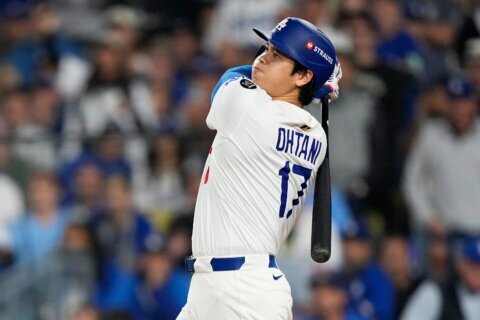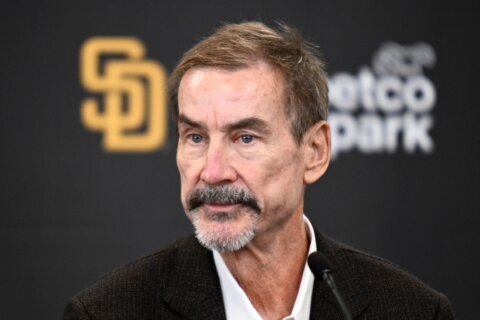WASHINGTON — “We’ll see how Coach Gwynn is feeling.”
I wasn’t thrilled with that response from the San Diego State University media relations staff, but I understood. I was hoping to talk to the Hall of Famer, the superstar who graced some of my most prized childhood baseball cards, the machine that squared up every ball he cared to lay his bat to, but also the man who had battled salivary gland cancer since 2010.
I had taken a cab away from the densely packed harbor area of the Gaslamp Quarter — home of one of baseball’s finest stadiums in Petco Park, which sits on the edge of San Diego Bay opposite Coronado — to visit the school.
It was graduation weekend in May 2013, and I had already walked around campus weaving through caps and gowns up to the cozy baseball stadium. The field was quiet and green, emblazoned with the school’s red and black logo behind home plate; the whole scene serene and idyllic under a perfect California sky.
Of course, I wasn’t even there to talk to Tony Gwynn about Tony Gwynn. I was there to ask about the most famous player to come out of the Aztec program during Gwynn’s tenure, Washington Nationals pitcher Stephen Strasburg. The Nats were in San Diego with Strasburg slated to toe the rubber in his hometown for the first time since becoming a big leaguer.
Gwynn’s health was visibly not optimal, but he was still happy to oblige me. We spent about 15 minutes in his dark, cramped, cluttered office wedged under the grandstands at Tony Gwynn Stadium, renamed after San Diego’s favorite son following a 1997 remodel.
Gwynn attended the university as an undergrad, initially playing only basketball. He picked up baseball his sophomore year, went on to forge one of the greatest hitting careers in the history of the game, then returned to campus, in the hills north and east of the city, where he had served as the head baseball coach since 2002.
He was ingrained in the city’s history and culture in a way nobody else was, having spent his entire adult life playing and teaching the game of baseball in San Diego.
Enumerating the accolades Gwynn collected over his career alone is enough to put a columnist over his word count. Eight National League batting titles. Fifteen All- Star selections. Seven Silver Sluggers. Five Gold Gloves. An impossible 19 consecutive seasons batting over .300. But perhaps his most significant awards were those he won just once.

Those three awards — and the fact that he won all of them — tells you just who Tony Gwynn was and what he meant to the game of baseball. He is one of only four men to be recognized with all three honors, along with Jamie Moyer, Curt Schilling and John Smoltz.
Perhaps that’s why, as we sat in this dark, cramped, cluttered office, Gwynn wanted to tell me about Strasburg’s maturation from the time he started as an under-recruited, out-of-shape freshman to his ascent to the top pitching prospect of a generation. He talked about Strasburg’s growth not as a player, but as a human being.
“The stuff he does on the field, he really had to work at,” he explained, discussing Strasburg’s physical improvement over the years. But he credited the pitcher’s mental makeup, which he said existed all along.
“All the other stuff, what you see now is what we saw when he came here as a freshman.”
Gwynn deserves at least some of the credit for harnessing that drive, though, helping mold Strasburg into one of the top young pitchers in the sport.
The two remained close over the years, with Gwynn making it out for Strasburg’s annual 5K fundraiser a couple years prior, despite the former’s poor health. A memento of their shared success sat on the shelf across from Gwynn’s desk — the Golden Field Award, given to the school as a counterpart to the Golden Spikes Award, which Strasburg won in 2009 as the top amateur player in the country.
The rest of the awards, the ones that simply can’t fit into this space, are stored in the school’s Sports Hall of Fame, a storage locker of trophies and framed photos with an entire corner devoted to Gwynn and his success.
But this day, we talked only about Strasburg. Gwynn watched video footage from the pitcher’s prior start on his computer as we chatted. And as great as that is, to talk and analyze baseball with a childhood hero, something is missing.
Gwynn’s voice seemed upbeat, but it lacked the animation, the liveliness that made his infectious personality so endearing. His famous laugh, the jolly bellow that accompanied his ear-to-ear grin with an ivory white smile were all absent. Subconsciously, I wished I could say something funny to bring it out of him. But deep down, I knew it wasn’t just me.
The scars from prior surgeries had left him with a slight vocal affectation, and restricted his facial muscles in a way that made that trademark grin impossible.
It’s hard to watch your heroes fade, and I remember the acute pain that accompanied the honor of getting to meet and chat with Gwynn that day. But it’s much harder to watch those heroes disappear entirely, especially when they are far too young.
Follow @WTOP and @WTOPSports on Twitter and WTOP on Facebook. .







